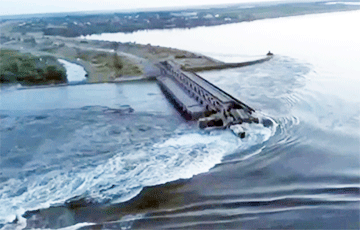NYT: Internal Blast Destroyed Kakhovka HPP
- 7.06.2023, 14:00
- 19,092

Munitions experts have described the most likely scenario for a dam failure.
An explosion inside the building is the most likely reason for the destruction of the Kakhovka Hydroelectric Power Plant. This is reported by The New York Times, citing experts in technology and ammunition.
A "structural failure" or attack from outside is possible, they said, but are "less plausible explanations".
NYT journalists once again reminded their audience that the Ukrainian authorities immediately announced that the dam had been blown up from the inside by the Russian occupiers. And representatives of the aggressor country gave "controversial comments." Later, Dmitry Peskov from the Kremlin, the press secretary of dictator Putin, announced "deliberate sabotage by the Ukrainian side".
Experts who spoke to the reporters warned that the evidence is very limited, but they believe an internal explosion is the most likely explanation for the collapse of the massive reinforced concrete dam.
They emphasize that an explosion in a confined space is more destructive since almost all of the blast energy is directed to the structures around. But an external explosion affects the object with only a small part of its force. Thus, much more explosives would be needed for an external blast than for an internal detonation.
“You are limited in how much [explosive] a warhead [missile] can carry. Even a direct hit might not destroy the dam,” said Nick Glumac, an engineering professor and explosives expert at the University of Illinois.
He emphasized that the dam is a structure that was originally designed to withstand huge masses of water, so the destruction of such a strong object would require a significant amount of energy.
Experts also admit the spontaneous collapse of the dam, which was previously subjected to shelling, in which the warring parties blamed each other. So, in August, a Ukrainian missile hit the road passing through the dam. Russian troops, retreating from Kherson, staged a powerful explosion, completely destroying part of this road in November.
Gregory Becher, a professor of engineering at the University of Maryland and a member of the National Academy of Engineering who has studied dam collapses, says dams sometimes fail on their own, but "it looks suspicious" in the case of the Kakhovka HPP.
“Since November, the overhead bridge cranes that open and close the sluice gates have hardly moved, although it is not clear why they did not work. This led first to record low water levels, and then to a 30-year record high water level when winter snowmelt and spring rains poured into the reservoir upstream,” NYT says.
Since the beginning of May, the water has risen above the gate and crossed over the top of the dam. Satellite images taken last week showed that much of the roadway had disappeared. But it is not yet clear whether the road was washed away by the flow of water or destroyed by some kind of explosion.
“The combination of a damaged sluice gate and flooding could cause several gates to break off, but it's unlikely that this would eventually tear apart the massive dam,” Professor Becher said.
On the morning of June 6, it became known that the Russian occupation troops had blown up the Kakhovka HPP. According to the Ukrainian Defence Intelligence, the explosion took place around 2:30 am (local time).
Ukrhydroenergo reported that the engine room detonated. The Kakhovka HPP is completely destroyed. The plant cannot be restored. According to the preliminary forecast, the reservoir is expected to be engaged within the next 4 days.
In total, 80 settlements can become a flood zone.
President of Ukraine Volodymyr Zelensky held an urgent meeting of the National Security and Defense Council due to the explosion of the Kakhovka HPP. At a meeting of the National Security and Defense Council, a set of international security measures was agreed to bring Russia to justice for the terrorist attack.
Andriy Yusov, the spokesman for the Ukrainian Defence Intelligence, said that Ukraine has evidence of a remote detonation of the Kakhovka Hydroelectric Power Plant by Russian occupiers. According to him, the Russian troops were transporting explosives and equipment for a controlled explosion in advance.










